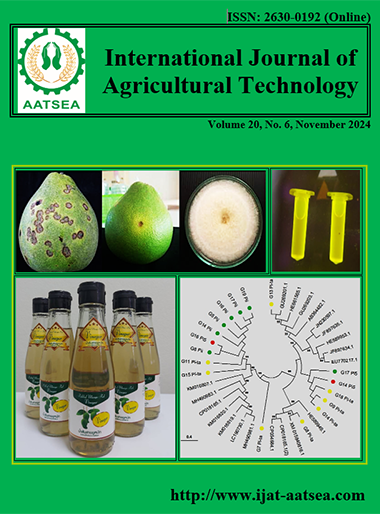Unravelling stress responsive NAC1 gene (OsNAC1) from potential Indonesia and Vietnam local varieties rice
Main Article Content
Abstract
The wide coastal area of rice production is reached 76.94% which showed the percentage of areas with high salinity constraints in Indonesia and Vietnam. The result was approximately 200 sequences from all samples which was similar to Oryza sativa Japonica Group NAC domain containing protein 92 (LOC4336052) transcribed transcript variant X2, mRNA (XM_015778438.2) for percentage of 95 – 98%. The conclusion confirmed that OsNAC1 gene from eleven genotype was someone similar evident by Phylogenetic construction result.
Article Details

This work is licensed under a Creative Commons Attribution-NonCommercial-NoDerivatives 4.0 International License.
References
Alshiekheid, M. A., Dwiningsih, Y. and Alkahtani, J. (2023). Analysis of morphological, physiological, and biochemical traits of salt stress tolerance in Asian rice cultivars at different stages. Preprints. https://doi.org/10.20944/preprints202303.0251.v1
BDR, M. F., Musa, Y., Ridwan, I. and Yassi, A. (2020). Screening of Indonesian rice (Oryza sativa L.) genotypes against salinity stress using NaCl under hydroponic condition. IOP Conference Series: Earth and Environmental Science, 575:012111.
BPS-Statistics Indonesia (2023). Paddy Harvested Area and Production in Indonesia 2022. Retrieved on November 19, 2024, from https://www.bps.go.id/en/publication/2023/08/03/a78164ccd3ad09bdc88e70a2/paddy-harvested-area-and-production-in-indonesia-2022.html
Duy, P. V. K. and Lien, Q. T. A. (2022). Evaluation of salt-tolerant traditional rice varieties in Mekong Delta, International Journal of Membrane Science and Technology, 10:1480-1484.
Ganie, S. A., Molla, K. A., Henry, R. J., Bhat, K. V. and Mondal, T. K. (2019). Advances in understanding salt tolerance in rice. Theoretical and Applied Genetics, 132:851-870.
Hairmansis, A., Nafisah, N. and Jamil, A. (2017). Towards developing salinity tolerant rice adaptable for coastal regions in Indonesia. KnE Life Sciences, 2:72-79.
Hu, H., Dai, M., Yao, J., Xiao, B., Li, X., Zhang, Q. and Xiong, L. (2006). Overexpressing a NAM, ATAF, and CUC (NAC) transcription factor enhances drought resistance and salt tolerance in rice. Proceedings of the National Academy of Sciences of the United States of America, 103:12987-12992.
Kawahara, Y., de la Bastide, M., Hamilton, J. P., Kanamori, H., McCombie, W. R., Ouyang, S., Schwartz, D. C., Tanaka, T., Wu, J. and Zhou, S. (2013). Improvement of the Oryza sativa Nipponbare reference genome using next generation sequence and optical map data. Rice, 6:1-10.
Le Hung, L., Tran, D. K., Nguyen, V. L., Dong, T. K. C., Le Duy, D., Ta, H. L. and Le Huy, H. (2012). Application of marker assisted backcrossing to pyramid salinity tolerance (Saltol) into Rice Cultivar-Bac Thom 7. VNU Journal of Science: Natural Sciences and Technology, 28(2).
Le, T. D., Gathignol, F., Vu, H. T., Nguyen, K. Le, Tran, L. H., Vu, H. T. T., Dinh, T. X., Lazennec, F., Pham, X. H. and Véry, A. A. (2021). Genome-wide association mapping of salinity tolerance at the seedling stage in a panel of Vietnamese landraces reveals new valuable QTLs for salinity stress tolerance breeding in rice. Plants, 10:1088.
Lubis, K., Lisnawita, L., Maathuis, F. and Safni, I. (2022). Trait selection and screening of Indonesian local rice accessions for iron stress tolerance. Biodiversitas Journal of Biological Diversity, 23(7).
Mao, C., Lu, S., Lv, B., Zhang, B., Shen, J., He, J., Luo, L., Xi, D., Chen, X. and Ming, F. (2017). A Rice NAC Transcription Factor Promotes Leaf Senescence via ABA Biosynthesis. Plant Physiology, 174:1747-1763.
Nakashima, K., Tran, L. P., Van Nguyen, D., Fujita, M., Maruyama, K., Todaka, D., Ito, Y., Hayashi, N., Shinozaki, K. and Yamaguchi‐Shinozaki, K. (2007). Functional analysis of a NAC‐type transcription factor OsNAC6 involved in abiotic and biotic stress‐responsive gene expression in rice. The Plant Journal, 51:617-630.
Prasetya, M. R. C. (2018). Pemetaan Tingkat Salinitas (Daya Hantar Listrik) Pada Lahan Sawah Tadah Hujan di Desa Durian, Kecamatan Pantai Labu, Kabupaten Deli Serdang. Jurnal Pertanian Tropik, 5:207-214.
Ramdhan, M. and Arifin, T. (2018). Geographic Informatuon system application in assessing the proportion of Indonesia's sea area, Scientific Geometrics Journal, 19:141-146.
Reddy, I. N. B. L., Kim, B. K., Yoon, I. S., Kim, K. H. and Kwon, T. R. (2017). Salt Tolerance in Rice: Focus on Mechanisms and Approaches. Rice Science, 24:123-144). Elsevier B.V. https://doi.org/10.1016/j.rsci.2016.09.004
Shahzad, B., Yun, P., Shabala, L., Zhou, M., Sellamuthu, G., Venkataraman, G., Chen, Z.-H., Shabala, S. and Wu, H. (2022). Unravelling the physiological basis of salinity stress tolerance in cultivated and wild rice species. Functional Plant Biology, 49:351-364.
Siregar, M. P. A., Hanum, C., Siregar, L. A. M. and Tistama, R. (2021). Morphological and physiological performance of brown rice (Oryza nivara L.) under salinity stress. SABRAO Journal of Breeding and Genetics, 53:228-238.
Tammi, R. S. (2022). Drought and salt tolerance characteristics of rice plants transformed with the SNAC1 transcription factor. http://repository.library.du.ac.bd:8080/xmlui/xmlui/handle/123456789/1843
Yang, S., Xu, K., Chen, S., Li, T., Xia, H., Chen, L., Liu, H. and Luo, L. (2019). A stress-responsive bZIP transcription factor OsbZIP62 improves drought and oxidative tolerance in rice. BMC Plant Biology, 19:1-15.
Zhang, X., Long, Y., Huang, J. and Xia, J. (2020). OsNAC45 is Involved in ABA Response and Salt Tolerance in Rice. Rice, 13(1). https://doi.org/10.1186/s12284-020-00440-1


